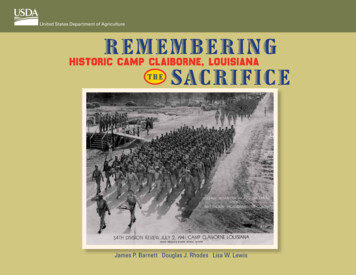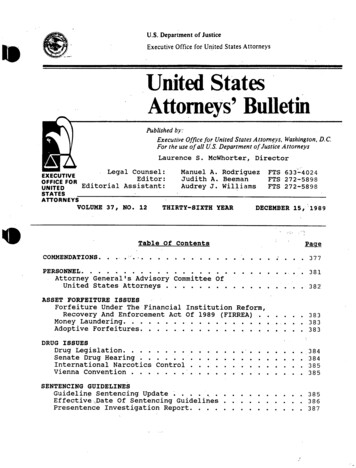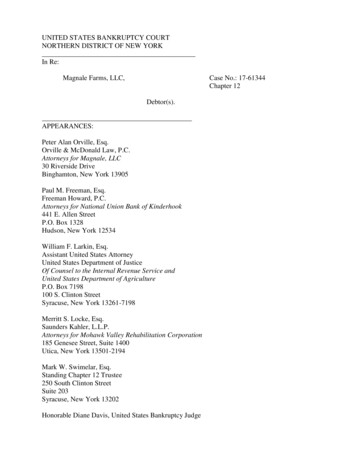
Transcription
United States Department of AgricultureREMEMBERINGHistoric Camp Claiborne, LouisianaSACRIFICETHEJames P. Barnett Douglas J. Rhodes Lisa W. Lewis
The AuthorsJames P. Barnett, Emeritus Scientist, U.S. Department of Agriculture, ForestService, Southern Research Station, Pineville, LA 71360.Douglas J. Rhodes, Deputy District Ranger, U.S. Department of Agriculture,Forest Service, Kisatchie National Forest, Boyce, LA 71409.Lisa W. Lewis, District Ranger, U.S. Department of Agriculture,Forest Service, Kisatchie National Forest, Boyce, LA 71409.Photo creditsMost of the photographs were taken by military photographers andare in the public domain. Additional credits are listed on page 110.Front Cover: 34th Infantry Division Review at Camp Claiborne, LA,July 2, 1941.Back Cover: Photo collage of pictures from Camp Claiborne from1941 to 1946.Forest ServiceResearch & DevelopmentSouthern Research StationGeneral Technical Report SRS-210August 2015Southern Research Station200 W.T. Weaver Blvd.Asheville, NC 28804www.srs.fs.usda.gov
REMEMBERINGHistoric Camp Claiborne, LouisianaTHESACRIFICEJames P. Barnett Douglas J. Rhodes Lisa W. Lewis
Past and present welcome signsto historic Camp Claiborne.The current Camp Claiborne welcome sign is located at the intersectionof US-165 and LA-112, a few miles north of Forest Hill, LA, on theCalcasieu Ranger District of the Kisatchie National Forest.
ContentsVii Preface711the Louisiana Maneuvers:Louisiana’s role in the buildup for war11131520Construction of Camp ClaiborneBoom TownCamp ClaiborneWest Camp Claiborne232530343742444648505258606268Major units trained at Camp Claiborne85 Leaders Who Established TheirCredentials at Camp Claiborne86 General George C. Marshall88 General Omar N. Bradley90 General Lesley J. McNair92 General Dwight D. Eisenhower94 General George S. Patton96 General Joseph W. Stilwell98 General Matthew B. Ridgway34th Infantry Division82nd Infantry Division82nd Airborne Division101st Airborne Division84th Infantry Division103rd Infantry Division761st Tank BattalionEngineer Unit Training Center91st and 93rd Engineer General Service Regiments711th and Related Engineer Railway Operating Battalions796th Engineer Forestry Battalion1312th Engineer General Service Regiment (Sawmill)20th General HospitalCorp Area Service Command Station Complement(Garrison Command)Life at Camp Claiborne101 Claiborne Today106 Concluding remarks108 References110 Acknowledgments111Abstract
Camp Claiborne in central Louisiana.
viiPREFACECentral Louisiana played a vital role inpreparing our military troops for wareven before the Japanese attack onPearl Harbor plunged the Nation into World War IIon December 7, 1941. In 1939, the U.S. Army’s totaltroop strength was 175,000 men, which includedthe U.S. Army Air Corps. The U.S. ranked 17th inworld-wide military capability, right behind thecountry of Romania (Nelson 1993). The Army waslargely an infantry force with supporting artillery,engineers, and cavalry, with only a few units beingmotorized or mechanized.Named in honor of GovernorWilliam C.C. Claiborne, the camp servedas a major military trainingcomplex for over 500,000 soldiers.As hostilities heightened in Europe, PresidentFranklin D. Roosevelt, Congress, and U.S. military leaders began their program of preparedness.In 1939, the Army National Guard and Reserveswere mobilized, and Selective Service Boards anddraft procedures were inaugurated. Citizen sol-diers came pouring in to fill out the ranks of theArmy and by 1940, the U.S. Army troop strengthhad grown to 1,400,000 men (Nelson 1993). Asthe number of new recruits continued to increase,existing military bases were enlarged; however,there was a need for additional military camps andlarge tracts of land for military maneuvers.To meet the need for additional trainingfacilities, the U.S. Army selected a site in theKisatchie National Forest, just north of the town ofForest Hill, LA, to construct a military training camp.In 1940, the camp was named Camp Claiborne inhonor of the first Governor of Louisiana, WilliamC.C. Claiborne. The camp became a major trainingcomplex that prepared over 500,000 soldiersfor war.Camp Claiborne was closed in 1946 afterthe end of World War II, and the site was returnedto the Kisatchie National Forest in 1947. AlthoughCamp Claiborne no longer exists as a militaryinstallation, it is timely on the 75th anniversaryof Camp Claiborne to remember the sacrifices ofthe many military men and women who trainedthere and went on to the major battlefields ofWorld War II.
the LouisianaLouisiana’s role in thebuildup for warManeuvers
2Army staff meeting with the locals.
3In 1939, after Germany overran Poland, the U.S.Government leaders began to gear up for America’sinevitable involvement in the war. As America’s relatively small and inexperienced army was rapidly expandingdue to the mobilization of the Army National Guard andReserves and newly instituted draft, the military neededan area to train soldiers and test new military tactics.In preparation for the Louisiana Maneuvers,representatives from the Third Armymet with local residents of central Louisiana.Army Chief of Staff General George C. Marshall believedthat the growing military ranks needed a complex trainingexercise that would closely approximate the realities of thebattlefield. General Marshall decided that most of the Army’sdivisions should train in the Southern United States whereweather was less likely to hamper operations. Army reconnaissance teams began scouting across the South, searchingfor the ideal location for the war games. General Marshallwanted the following criteria: a varied terrain to test soldiersand equipment under different conditions; “thinly populatedcountry” that was “conveniently and economically accessible”to participating divisions; and a willing population who wouldnot demand huge reimbursements for any damage caused bythe military (Kane and Keeton 2004).Marshall called on Lieutenant General Stanley D.Embick, a veteran soldier and commander of the Third U.S.Army, to find a suitable location to host the largest concentration of military maneuvers inside the continental UnitedStates. With his aide, Major Mark Clark, Embick traveled tocentral Louisiana with a tattered road map as a guide. Theytramped through Louisiana’s backcountry noting the roads,trails, swamps, and forests. The area was described as a “40 by90 mile sparsely settled, chigger and tick infested bayou andpitch pine section between the Sabine and Red Rivers” (Allen1947). One of the advantages of the area, in addition to itssparse population and availability of Kisatchie National Forestlands, was the large amount of vast open tracts of land thatwould allow easy deployment of troops, vehicles, and tanks inlarge-scale maneuvers. These ideal open conditions resultedfrom aggressive harvesting of the old-growth longleaf pineforest by steam-powered railroad logging equipment duringthe early 20th century (Barnett 2011).It was decided that a 3,400 square mile sparsely populated area in central Louisiana between the Sabine and RedRivers would be the ideal location to hold the war games. The1940 and 1941 maneuvers, call the Louisiana Maneuvers,created a flurry of interest throughout the military. The1940 maneuvers began with 70,000 soldiers who trainedand “fought” in separate exercises of 3 days each. These firstmaneuvers were described by Embick as “experiments” notcontests (Perry 2008).
4Brig. Gen. Lesley “Whitey” McNair replaced Embick,who was retiring, to conduct the 1941 maneuvers (The BigOne) that would mobilize nearly 500,000 soldiers from 19divisions in the largest peacetime exercise in American history (Gabel 1992). Smaller maneuvers were conducted in1942 and 1943. One scheduled for 1944 was cancelled becauseof the planned invasion of Europe.The central Louisiana landscape provided optimumtesting grounds for large vehicles and tanks.The M1 combat car was an all-machine-guntracked vehicle which held a crew of four.The M2 was an early version of theStuart light tanks and was used in the earlybattles of the Pacific War.M2 light tanks mired attempting to cross a stream.Units involved in the Louisiana Maneuvers generally had several months to prepare—all but one. The 502ndParachute Battalion, which had just organized in July 1941,received orders for a company to proceed to Louisiana only 16days before the maneuvers were to begin. The Battalion wasan experimental unit formed to test the doctrine and tacticsof parachute assault. No one in the chain of command exceptheadquarters in Washington, DC, knew of this type of unit inthe Army. So, when 127 men made a combat jump into thearea, they caused uncertainty and confusion with the publicand disrupted the military maneuvers (Robertson 2014).
5During the Louisiana Maneuvers near Clarence, LA,field hands were harvesting cotton as they watched aircraftpassing overhead. As they were watching the airplanes, theybecame confused when they saw men descending from theaircraft under umbrella-like chutes.Equally confused were the military units involved in themaneuvers. The airborne troops captured ground troops, blewup a pontoon bridge, and were fired upon by the surprisedfriendly army troops. The maneuvers’ umpires disqualifiedtheir accomplishments because they were not within the organizational structure.The 502nd Parachute Battalion was re-designated as thend502 Parachute Infantry Regiment on March 2, 1942, and joinedthe newly created 101st Airborne Division in August 1942.The Louisiana Maneuvers were designed to providevital training for hundreds of thousands of American soldierswho would go on to fight and win in the battlefields of Europeand the Pacific. Notable Army Officers such as LieutenantColonel Omar Bradley, Major General Walter Short, MajorGeneral Krueger, Brigadier General Adna P. Chaffee, ColonelGeorge S. Patton, Colonel Dwight D. Eisenhower, GeneralJoseph Stilwell, and Major Mark Clark all participated in theLouisiana Maneuvers and went on to become highly decorated military leaders in World War II.LieutenantColonel OmarBradley (left)discussingmaneuver tacticswith GeneralLesley McNair.The 502nd Parachute Battalion leads an airborneassault during the 1941 Louisiana Maneuvers.
6Third Army maneuvers, 1940. The M1 combat car (foreground) wastaken out of service in 1943, with only 113 units ever produced.
7Company A, 7th Engineers of the RedArmy is constructing a bridge foran assault on the Blue Army nearBurr’s Ferry in 1940.A 367-foot bridge across the Sabine River built in 5 hours by Company A, 7th Engineers.
8Mounted calvary moves along a dusty road.The Louisiana Maneuvers did much to identify weaknesses, develop strategies, and identify leadership potential ofofficers. General George Marshall, Chief of Staff of the Army,stated before the end of the maneuvers, “I want the mistakesmade in Louisiana, not in Europe. If it doesn’t work, find outwhat we need to do to make it work” (Bailey 2009). The maneuvers also allowed Army strategists to test conventional defenseswith attacks from more modern armored vehicles.The Louisiana Maneuvers helped to bring a close to theonce glorious role of mounted cavalry troops as they gave wayto tanks. As a result, an important framework for the effectiveuse of tanks in battle was developed. Patton’s observation ofthe maneuvers resulted in his statement: “If you could takethese tanks through Louisiana, you could take them throughhell.” Letters sent home from troops involved in the maneuvers told stories of very trying conditions (Larsen 2014).The Louisiana Maneuvers included trainingexercises for the cavalry, which utilized horses totransport troops, supplies, and artillery.Calvary dismounts for an assault.The Louisiana Maneuvers served as a vast laboratory fortesting strategies and innovations. Officers were able to evaluate troop adaption to new weapons such as the Garand M-1semi-automatic rifle and 105-mm howitzer. For the first time,C-rations were consumed by large numbers of troops, andmobile kitchens and hospitals were tested in the field wherethey adapted to new, faster-moving triangular infantry divisions (Kane and Keeton 2004).
9The 1st Calvary Division hauls a 75-mm pack howitzer. Note the 1st Calvarypatch on the ammunition caisson and the hay for the horses above it.
Construction of Camp Claiborne
12Temporary and semi-permanent structures of early Camp Claiborne, circa 1940.At the close of the May 1940 Louisiana Maneuvers,Lieutenant General Stanley D. Embick,Commander of the Third Army, said “.the state[Louisiana] is ideal for military training.” Louisiana’s importance in the Nation’s military preparedness seemed to be gaining momentum (Kane and Keeten 2004). In August 1940,Army Chief of Staff, General Marshall, visited Louisiana anddeclared that central Louisiana provided the “finest trainingareas” he had ever seen. Almost immediately, speculationspread that the military might choose Louisiana for the location of much needed new training camps and maneuver areas.
13Within a 50-mile radius of Alexandria, LA, four majorcamps, four airfields, and numerous bombing and artilleryranges were developed. Lands from the newly establishedKisatchie National Forest were transferred to the Departmentof War to establish Camps Claiborne, Livingston, and Polk.These all received new divisions to train.An Army division consists of approximately 10,000 to15,000 soldiers. The U.S. Army had a goal of 100 divisions,but had to settle for 89 divisions. Of the Army’s 89 divisions,45, or over half, of the divisions trained in central Louisianabefore going to war in the European, North African, or PacificTheaters.Workers parked along present-day US-165and were shuttled to work sites.Boom TownAs news of the need for construction workers tobuild Camp Claiborne spread, thousands of mendescended on Forest Hill, LA, eager to find work,earning on average 1.10 per hour. The first constructionworkers arrived in 1940 to find no available housing. Worker’shad to improvise their own housing, usually with left over orscrap materials from the construction of the camp.The need for construction workers attractedthousands of men and their families to the area.But housing and work-site parking were scarce,and the workers had to improvise.A family from Texas sleep in the car and cook and eatin a lean-to. Note the family pet in the foreground.
14‘A market and a cafe.‘ with school bus that was used toCafetransport workers around the camp.Construction of temporary housing that provided room and board.
15It didn’t take long, however, for enterprising individualsto start building cafés, general stores, and housing to meet theneeds of the workers building Camp Claiborne.Buildings such as these sprang up almost overnight andprovided much needed amenities to the thousands of men whohelped construct Camp Claiborne. Land near Camp Claiborne,which was formerly of very little value and difficult to sell, nowsold for 200 per acre.Basic amenities such as cafés provided a place for construction workers to get a hot cooked meal. Other facilitiesprovided workers a place to take hot showers or get a haircut,while others provided laundry services.There were also rental properties, which were nothingmore than small, hastily constructed cabins which housedmultiple workers.Camp ClaiborneIn less than 1 year over 8,000 construction workersbuilt hundreds of semi-permanent buildings andthousands of pyramidal-type tents with wooden floorsand sides. In addition, they constructed many miles of roads,sewer lines, sewage treatment plants, a complete electricalgrid, and natural gas lines. The total cost of construction was 14,000,000 (Times-Picayune 1941).Buildings sprang up almost overnight and providedmuch needed amenities to construction workersand their families. Cafés were popular places forconstruction workers to gather in the evenings.Small rental properties.
16Pyramidal-type tents with partial siding and woodenfloors were used initially to house soldiers.Initially constructed to accommodate some 30,000officers and troops, the camp was officially opened for usein January 1941. Construction was still underway when the34th Infantry Division arrived at Camp Claiborne in March of1941. The 34th Division was housed in pyramidal-type tentswhich had wooden floors with partial wooden sides.In January of 1942, to ease a growing shortage of canvas,the Army Quartermaster General urged the conversion of allpyramidal-type tents to wooden hutments. These structureswere constructed in two sizes—those for enlisted personnelhousing 15 men, and smaller ones that accommodated twoofficers.Pyramidal-type tents were usedinitially to house soldiers while hutmentswere being constructed.Pyramidal-type tent frames under construction.These wooden hutments were constructed with ventilated roofs and siding, and the interiors were unfinished barewalls; screened doors and windows were added—essential forthe hot, humid summers in Louisiana. It is interesting to notethat all hutments at Camp Claiborne contained natural gasheaters.In the rush to house the soldiers, hutments were hastilyconstructed using lumber which in many cases was not properly dried. This resulted in excessive warping and shrinkage,causing gaps in the flooring and siding of the buildings. Asa result, the exterior of the buildings were covered with construction roofing felt.
17Construction workers move a pre-fabricated pyramidal-type tent.Exterior view of eight-man pyramidal-type tents.
18The roof and wood siding is installed on a hutment.Gas lines and electricity are added.Hutments are completed with screens and roof ventilation.
19Aerial view of Camp Claiborne as originally constructed, 1941.
20West Camp ClaiborneIn 1942 with the growing demand for specializedskills needed to support both infantry and armorunits, the Army Service Forces Command neededan area to establish an Army Service Forces Training Center.This training center was needed to train new recruits in basiccombat survival skills as well as specialized training in variousengineering support specialties. These specialties included,but were not limited to: auto mechanics, heavy equipmentoperators, bridge building, petroleum supply, road construction, building construction, sawmill operations, and railroadengineer companies.Match book cover from ArmyService Forces Training Center.West Camp Claiborne became a trainingcenter for the Army Service Forces, andsupplemental housing and support facilities werebuilt to accommodate the additional soldiers.
21In March of 1942, Brigadier General John W.N. Schulzmade a visit to Camp Claiborne to determine if it would be asuitable site to house the newly formed training center. In aletter back to the Army Chief of Engineers, Schulz concludedthat “ the use of West Camp Claiborne for the OrganizationCenter is not desirable if it can be avoided [but] there appearsto be no alternative .” Within a few months of GeneralSchulz’s visit to Camp Claiborne, West Camp Claibornewas officially re-designated as the Army’s first EngineerUnit Training Center. General Schulz was named as thefirst Commander of the Engineer Unit Training Center andremained in command of the training center until October1943 (Coll and others 1958).The establishment of West Camp Claiborne as theEngineer Unit Training Center added an additional 20,000troops. This resulted in the need to build additional housingand support facilities. West Camp Claiborne comprised thelargest single concentration of engineer soldiers in the Nation.West Camp Claiborne was attributed with preparing the bulkof U.S. Engineer troops for deployment overseas (Combs1994). By the fall of 1943, West Camp Claiborne reached itspeak, training of 31,000 men at one time.Brig. Gen. John W.N. Schulz (seated next todriver) with members of his staff, 1942.
MAJOR UNITS trained AT CAMP CLAIBORNECamp Claiborne was unique in the numberand type of military units that trained at its facilities.During its brief 6-year existence from 1941 to 1946, over500,000 soldiers trained there before being deployed toEurope, North Africa, and the Pacific.Some of the major and specialized units that trainedat Camp Claiborne are presented in this section.
24Official welcome ceremony of the 34th Infantry Division, March 8, 1941.Note soldiers marching into the review area from three directions.
2534th Infantry DivisionFirst train load of soldiers to arrive, February 20, 1941.The 34th Infantry Division, consisting of NationalGuard personnel from North and South Dakota,Minnesota, and Iowa, was activated as part ofthe buildup for World War II on February 10, 1941. The 34thInfantry Division began to arrive at Camp Claiborne on Friday,February 20, 1941. When they arrived, Camp Claiborne wasstill under construction.Soldiers of the 34th Infantry Division began arrivingat Camp Claiborne in February, 1941,and they were officially welcomed in March.The 168th Infantry Regiment of the 34th Infantry Divisionincluded machine gun crews. The picture to the right showsa crew firing a .30 caliber water-cooled machine gun. Themachine gun crew is “dug in” and is using local vegetation tocamouflage their position. Note they are still wearing WorldWar I era helmets.Soldiers in this regiment also received rifle training.Shown here, they are qualifying on the rifle range with their.30 caliber Springfield rifles. Note the troops are wearingdenim dungarees which were standard issue between WorldWar I and World War II.InfantryDivision patch.Background is anolla, a Mexicanwater bottle,with the skullof a bull.Machine gun crew,34th Division, 168thInfantry Regiment.Qualifying on the rifle range, 34thDivision, 168th Infantry Regiment.
26Captain C.E. Herring in officer’s tent.10 Minnesota enlisted men of the headquarters battery 151stField Artillery bite into the “Furlough Sugar Cookie.”Exterior view of an officer tent.
27Troops received support beyond Camp Claiborne.On Cookie Day, the girls of Pillsbury’s cooking service inMinneapolis, MN, sent to the camp a large cookie, which theynamed the “Furlough Sugar Cookie.” Cookie Day sponsor,Chaplain Deloss I. Marken of the 34th Division, stated “It wasthe largest cookie in Louisiana.” The cookie recipe called for 4pounds of flour, 2 pounds of shortening, 4 pounds of sugar,and 8 eggs. It took 900 raisins to write, “To Camp Claiborne”in the frosting.When off duty, officers and enlisted men enjoyed leisuretime. Officers were housed in two-person pyramidal-typetents. Enlisted men shared larger, eight-person tents. CaptainC.E. Herring, with the 168th Infantry Regiment, 34th Division,is shown relaxing in his two-person officer’s tent.Wooden hutments replaced the pyramidal-typetents. These semi-permanent structures providedamenities such as electricity and gas heaters.Interior of pyramidal-type tent for enlisted men.
28133rd Infantry Headquarters and Battalion Headquarters Company, July 2, 1941,in review in front of their Divisional Headquarters, Camp Claiborne.
29The 34th Infantry Division, known as “Red Bulls”, performed outstandingly during the maneuvers. Because ofthat, and its advanced state of training, the 34th Division wasselected as the first American contingent to cross the Atlanticand enter what would eventually become the European Theaterof Operations. On January 26, 1942, just 6 weeks after PearlHarbor, over 4,000 personnel, primarily from the Red BullDivision, arrived at Belfast, Northern Ireland. Rigid training,including amphibious training and maneuvers, became theorder of the day. The 34th Infantry Division did not remain longin Northern Ireland. In the latter part of October, the Divisiondeparted the Belfast area in route to North Africa, where it tookpart in Operation Torch and conducted amphibious landingsin the vicinity of Algiers. The Division would go on to play akey role in major campaigns in North Africa and Italy.By January 1, 1942, the 34th Infantry Divisionwas on its way to Fort Dix, NJ, and becamethe first U.S. Division to be shipped overseas.The U.S. Rangers trace their lineage through the 34thInfantry Division. It was while training in Great Britain thatvolunteers from the 34th Infantry Division provided 80 percentof the men for a newly formed 1st Ranger Battalion, and many ofthem participated with the British Commandos in the famousraid on Dieppe, France. The 1st Ranger Battalion was formedunder the command of one of the Division’s officers, CaptainWilliam O. Darby, and they soon became famous as “Darby’sRangers” (Jeffers 2007).During World War II, the Red Bulls participated in sixmajor Army campaigns in North Africa, Sicily, and Italy. TheDivision is credited with amassing 517 days of continuous frontline combat, more than any other division in the EuropeanTheater. One or more 34th Division units were engaged inactual combat with the enemy for 611 days. Casualties in the34th Infantry Division are considered the highest of any division in the Theater. Red Bull soldiers were awarded 10 Medalsof Honor, 98 Distinguished Service Crosses, 1 DistinguishedService Medal, 1,052 Silver Stars, 116 Legion of Merit medals,1 Distinguished Flying Cross, 1,713 Bronze Stars, 51 SoldierMedals, 34 Air Medals, with duplicate awards of 52 oak leafclusters, and 15,000 Purple Hearts.The Division returned to the United States on November3, 1945, and was inactivated at Camp Patrick Henry, Virginia,that same day after nearly 5 years of arduous service.
3082nd Infantry DivisionThe 82nd Infantry Division was formally activatedon August 25, 1917, at Camp Gordon, Georgiaduring World War I.The 82nd Infantry Division was nicknamedthe “All American” because itcontained draftees from all 48 States.82nd Infantry Division Headquarters, 1942.The AAstood for“The AllAmericanDivision.”The 82nd Infantry Division was re-activated on March25, 1942, at Camp Claiborne, Louisiana. Major GeneralOmar Bradley was named the Division Commander, andBrigadier General Matthew Ridgway was named the AssistantCommander. The Division was composed mainly of drafteesfrom Alabama, Georgia, Mississippi, and Tennessee.To stimulate esprit de corps in the 82nd, Bradley andRidgway stressed the Division’s outstanding World War Irecord in every aspect of training at Camp Claiborne (Mrozek2000).In June of 1942, General Bradley was transferred toCamp Livingston, Louisiana, to Command the 28th InfantryDivision. Assistant Commander Matthew Ridgway assumedcommand of the 82nd Infantry Division.
31Sergeant Alvin C. York, 82nd Infantry Division, wasone of the most decorated American soldiers in World WarI. He received the Medal of Honor for leading an attack ona German machine gun nest, taking 32 machine guns, killing 28 German soldiers, and capturing 132 others. This actionoccurred during the U.S.-led portion of the Meuse-ArgonneOffensive in France. In addition to the Medal of Honor, Yorkwas presented with the French Croix de Guerre and Legion ofHonor, as well as the Italian Croce de Guerra.On May 7, 1942, Sergeant York addressed the assemblednd82 Division on the parade grounds in front of the DivisionalHeadquarters at Camp Claiborne. Sergeant York’s speech wasone of six 15-minute radio programs that were broadcast byCBS from Army camps around the country. The name of theseries was titled, What are we fighting for?In his address, York related his exploits in the “GreatWar” including the events which led to his award of theMedal of Honor (Mrozek 2000).Sergeant York told the troops, “ you boysare going to have to finish the job we thoughtwe had finished for all times ” and“ freedom is not anything you can winonce and for all .”You can hear Sergeant Alvin York’s entire address tothe 82nd Infantry Division broadcast from Camp Claiborne athttps://archive.org/details/WhatAreWeFightingFor 496.Sergeant Alvin C. York during World War I.
32Sergeant Alvin C. York’s address to the 82nd Infantry Division, May 7, 1942, at the parade grounds in front of the DivisionHeadquarters. Sergeant York was promoted to the rank of Major in the U.S. Army by Major General Omar Bradley that same day.
33
3482nd Airborne DivisionOn August 15, 1942, 82nd Infantry DivisionCommander, General Matthew Ridgway,informed the Division that they would becomethe Nation’s first airborne division.The 325th and 326th Infantry Regiments became the82nd’s Glider Infantry. After 6 months of training, the 82ndAirborne Division moved from Camp Claiborne, LA to Ft.Bragg, NC. The 325th Glider Infantry, along with the 504th andthe 505th Parachute Infantry, rounded out the 82nd AirborneDivision.The 82nd Infantry was re-designated as the82nd Airborne Division in front of their divisionalheadquarters at Camp Claiborne.First and last review of 82nd Airborne Division.The 82nd Airborne Division left Fort Bragg, NC, on April20, 1943, for a journey that would take the Division to ninecountries. The Division fought in Sicily, Italy, and France. TheDivision was relieved and then moved to England to preparefor the invasion of Holland, during Operation Market Garden.On September 17, 1944, the 82nd Airborne Division tookoff from airfields in England in route to German-occupiedHolland.C-47 transports towed the Waco-CG-4A gliders. TheCG-4A gliders could carry up to 13 troops and their equipment. Cargo loads could be a 1/4-ton truck (i.e., a Jeep), a75-mm howitzer, or a 1/4-ton trailer, loaded through theupward-hinged nose section.
35On December 16, 1944, lead elements of a Germanoffensive broke through the American line in the ArdennesForest of Belgium. The only reserve forces available werethe 82nd and 101st Airborne Divisions. The 82nd was alertedon December 17, 1944 and by the next evening was inWebermont, Belgium, on the northern shoulder of the bulgecreated by the enemy attack.On the morning of December 19, 1944, the 82ndAirborne took up defensive positions alo
States. With his aide, Major Mark Clark, Embick traveled to central Louisiana with a tattered road map as a guide. They tramped through Louisiana's backcountry noting the roads, trails, swamps, and forests. The area was described as a "40 by 90 mile sparsely settled, chigger and tick infested bayou and











